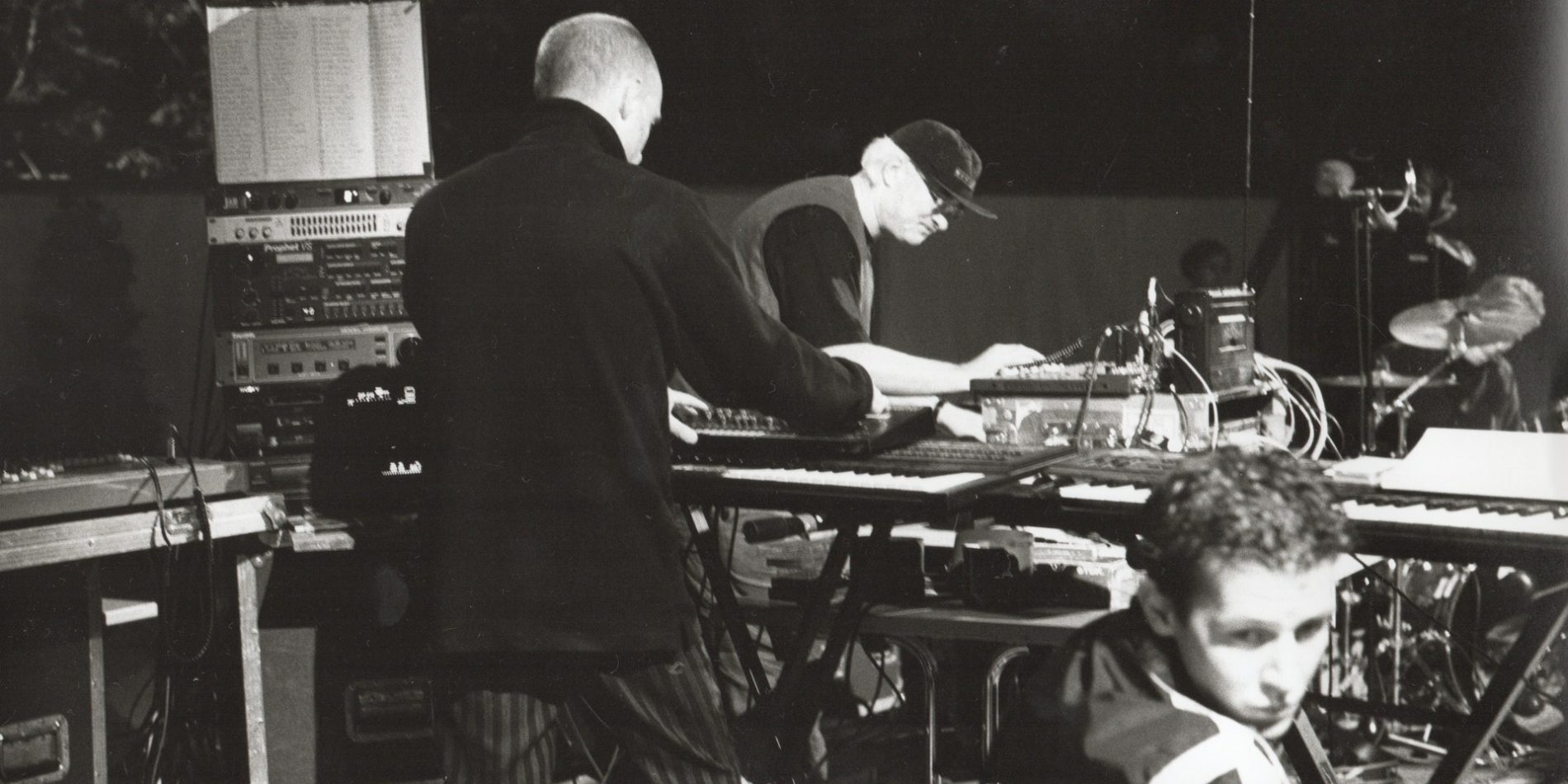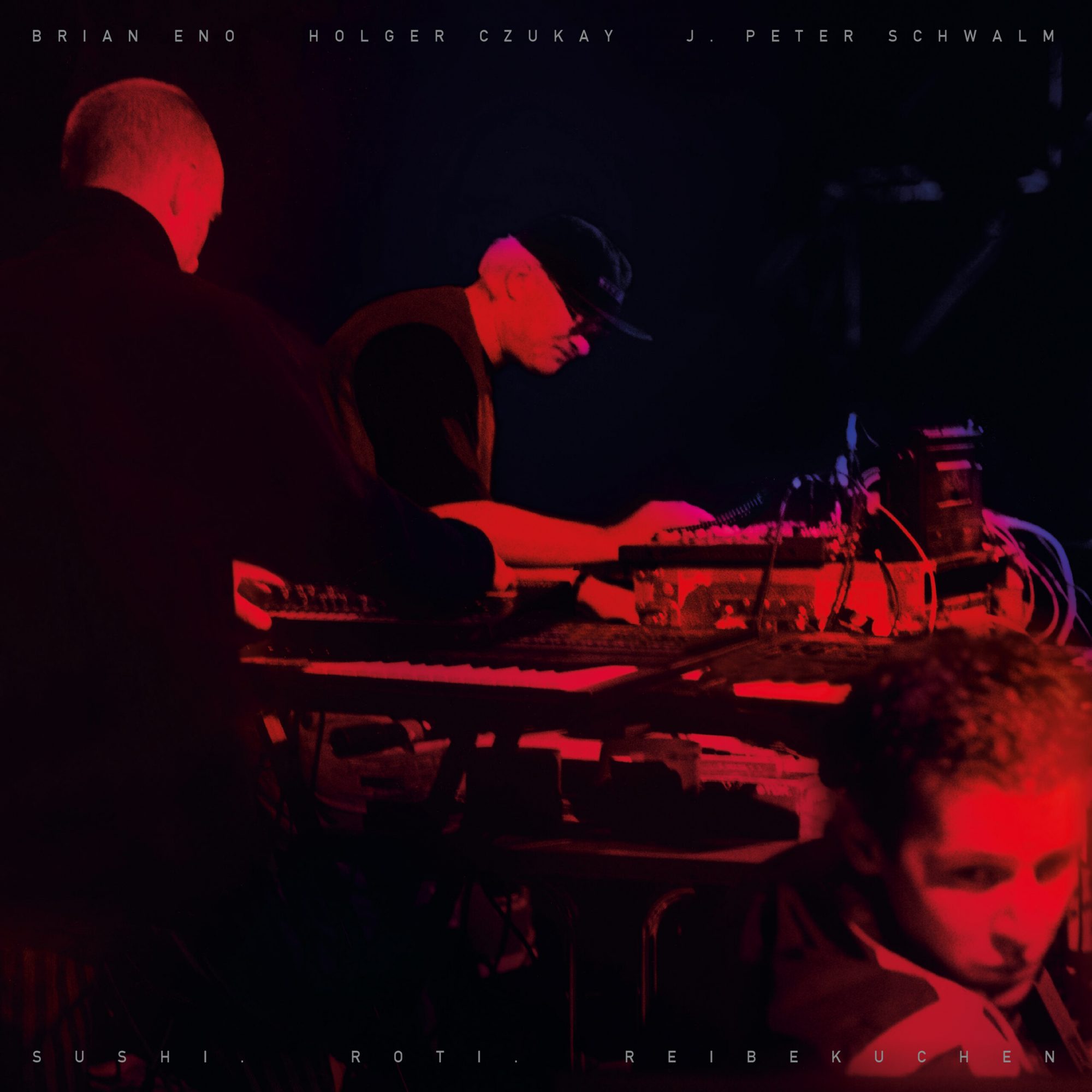Brian Eno, Holger Czukay & J. Peter Schwalm – SUSHI! ROTI! REIBEKUCHEN!
The lost audio from a 1998 performance by experimental music legends resurfaces. Buy the album & watch the original live stream video

Brian Eno is such a respected figure in the music world that his legend continues to transcend generations. Whether it’s his early work in Roxy Music and his run of landmark solo releases throughout the 70s; collaborations with folks like David Byrne, John Cale, and Robert Fripp; or you’ve simply heard him referenced in an MGMT song, it seems that nearly everybody is aware of the name ENO. These days, he’s most widely recognized as a producer (Talking Heads, DEVO, U2, Bowie) and for his groundbreaking work in electronic music – particularly in the ambient realm – but the self-proclaimed “non-musician” is also notorious for keeping his ear to the street and mining the underground. One highly regarded instance of this was the 1978 No New York compilation he produced, which helped to coin the term “No Wave.” However, one of the most influential and enduring explorations he ever took was into the world of Krautrock/kosmiche Musik. Today, a lost recording of Eno with one of the most important figures in the genre has finally been made available a quarter-century after it was originally recorded.
In 1974, Brian was at a turning point in his career when he caught a Hamburg performance by Harmonia and spontaneously joined them on stage. Around this time, Eno famously referred to the German trio as “the world’s most important rock group.” Formed by Dieter Moebius and Hans-Joachim Roedelius of Cluster, alongside fellow Krautrock pioneer, Michael Rother (NEU! / early-Kraftwerk), the members were living and working together in a 16th-century hamlet in the Forst district in Lower Saxony, Germany. Eno sought to visit the band at their rural homestead, but by the time he finally hit them up 2 years later, the project had essentially disbanded. They welcomed him anyway and, during his 11-day trip, he casually hung out with his hosts while creating 3 tapes worth of music. These recordings wouldn’t see the light of day for another 3 decades when the sessions were eventually arranged and mastered into the album Tracks And Traces, credited to Harmonia 76.
There was never any intention to record an official album, but there were plans for Eno to return for further experimental sessions with his new collaborators. This never happened, as he went directly into the recording sessions for David Bowie‘s future-classic, Low (1977). The influence of his work with Harmonia — along with the greater Krautrock scene, of which Bowie was equally infatuated — permeated the album, as well as Heroes (1977) and Lodger (1979), the other 2 releases in Bowie‘s famed Berlin trilogy. Eno would go on to release a pair of albums with just Moebius and Roedelius, both of which featured cameos by CAN‘s Holger Czukay on bass. A year after Tracks And Traces finally came out, Eno would record an extensive and somewhat mythical improvisational performance with Czukay that, similarly, wouldn’t resurface for another two-and-a-half decades.

Released today by London‘s Grönland Records, SUSHI! ROTI! REIBEKUCHEN! documents a lost live performance by Eno, Czukay, and J. Peter Schwalm, accompanied by Raoul Walton (bass) and Jern Atai (drums) from Schwalm’s electro-jazz project, Slop Shop. Recorded on August 27, 1998 outside the Kunst-und Ausstellungshalle der Bundesrepublik Deutschland (the Art and Exhibition Hall of the Federal Republic of Germany) in Bonn, Germany, the performance was arranged as part of the opening celebration for an exhibition of Eno‘s Future Light-Lounge Proposal multimedia installation. The name SUSHI! ROTI! REIBEKUCHEN! is a reference to the food that would be served, as the music component was presented to operate more like background music for the “top-level chefs” that were hired and the estimated one to two-thousand diners at the opening.
By this point in his career, Brian‘s disinterest in performing live had long been noted, making this occasion only that much rarer. At least by bringing in collaborators, he wouldn’t be taking the stage alone. Billed as a “High-Altitude-Food-Performance with Incidental Music by Slop Shop and Brian Eno,” there was no advanced mention of Czukay‘s involvement in the event, at all. Apparently, even Schwalm was completely unaware that the late-CAN founder would be there until arriving for rehearsal the night before the show. Furthermore, Schwalm and Eno had only ever met on 2 prior occasions before their rehearsal.
The following excerpt is taken from a press release written by Wyndham Wallace and sets the scene for the night of the show.
“…Under clear skies, they slipped quietly, one by one, onto a stage filled with tangled cables and musical equipment. [Brian’s friend, Rolf] Engel had arranged for Eno to have equipment similar to that in his studio, and for the next three hours they extemporized, often building more robust music on initially ambient foundations, pivoting between eerie soundscapes , dub, electronica, musique concrete, and even drum and bass, playing to their respective strengths. Each had their own role, with Eno and Schwalm working with synthesizers, sequencers and processors while leading the tight-knit rhythm section of Atai and Walton , while Czukay , dressed in a brown vest and T-shirt black, with his characteristic handlebar mustache and striking white hair, was, Schwalm recalls, the “soloist . ” “It was a lot of fun watching him constantly change tapes. All these voices were played by Holger. Sometimes I didn’t know where these funny noises were coming from. At one point, the Pope suddenly began to speak! »
Meanwhile, the audience, including a host of German celebrities, feasted on the title cuisine and drank free glasses of wine. Of course, even though Eno had planned to only provide background music, it was impossible to ignore. First, as Schwalm points out , “we had some very intense, fast-paced pieces where it’s hard to eat, and you can’t eat for three hours anyway . ” There was also the inevitable detail that this was one of the first times in a quarter of a century that Eno had been seen performing in public, and so people could be forgiven for getting excited. Nevertheless, the group managed to maintain the informal atmosphere of the previous day’s rehearsal, even going so far as to move away from the stage at certain moments. Legend has it that the only reason the concert ended, after an additional hour of improvisation following an initial two-hour session, was the arrival of the police to cut off the power.”
Although Schwalm and Eno would go on to collaborate afterward – the pair released the album Drawn From Life in 2001 – the five musicians would never work together again as a unit. The magic they created that night seemed to be relegated to that moment. Schwalm had some form of recording from that evening, which he sifted through “choosing the sections that he felt best represented what they had accomplished,” but they ultimately remained in the archives until now. Promoted as a distillation of the “highlights” from that evening, this new hour-long SUSHI! ROTI! REIBEKUCHEN! release from Grönland is currently available on vinyl, CD and through all digital platforms.
One thing that particularly fascinates me about the performance is that, due to Eno‘s consistent embrace of new technology, the event was simulcast live via the internet. Being that it was 1998, however, it’s hard to imagine how many people managed to stream it at the time. In the materials that we read, there is much lamentation about the inability for anyone outside of that room to witness what they conjured up on that evening over 25 years ago, but we’ve discovered that there actually has been a noteworthy documentation of the events online for the past 9 of those.
A Youtube account by the name University Of Ambience published the large majority of what was streamed that night, minus the second set, which was never broadcast. The caption under the video, which is incredibly informative, provides the following details.
“The event was streamed live using RealVideo streaming technology, which was designed to provide high quality video and audio over the slow dial-up Internet connections and 14.4/28.8/56 kbps modems that were in existence in 1998. This explains the pixel clumping effects that make up the video images, and the somewhat tinny audio. As the KAH’s link no longer works, and many people do not have the software to play Real videos anyway, the University has preserved the file for a YouTube audience.”
While it’s true that those of us who were not in attendance will never fully understand what it was like to be there, between this new live LP and the video we have available, we should be able to get a respectable glimpse at the magic.
You can view the entire 2-hour YouTube video below and, if you happen to check out the comments, you’ll find that the top one posted is from J. Peter Schwalm, himself. In the comment, which is from 6 years ago, the German composer/producer states, “i have recorded this evening on 24tracks and will mix at some time. when i have the time…”
We, for one, appreciate him getting around to it.